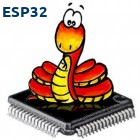-
Notifications
You must be signed in to change notification settings - Fork 345
thread_example_1
Boris Lovosevic edited this page Jan 27, 2018
·
3 revisions
Two threads will be created, performing simple arithmetic operations.
Both threads will use the same function, but with different arguments.
First, we need to import the needed modules and create the thread function:
import machine, time, _thread
# Both threads will use the same function
def th_func(tmr):
x = 0
f = 1.1
ntf = 0
tm = 0
n = 100000
start_time = 0
end_time = 0
myname = _thread.getSelfName()
# Init the thread timer
t = machine.Timer(tmr)
t.init(mode=t.CHRONO)
while True:
ntf = _thread.wait()
if ntf == _thread.EXIT:
# Terminate the thread
return
elif ntf > 0 and ntf < 5:
# Start the instruction loop
if (ntf == 2) or (ntf == 4):
# For commands 2 and 4
# Lock the thread, other threads will not execute
_thread.lock()
# Get start time and start the timer
start_time = time.ticks_us()
t.start()
if ntf < 3:
# For commands 1 and 2 run integer addition test
for i in range(0, n):
x += 1
else:
# For commands 3 and 4 run float multiplication test
for i in range(0, n):
f *= 1.2345
# Stop the timer and get the end time
t.stop()
end_time = time.ticks_us()
if (ntf == 2) or (ntf == 4):
# Unlock the thread, other threads can now run
_thread.unlock()
# Get the elapsed time
tm = t.value()
elif ntf == 7:
# Print the operation summary
print("[{}] Elapsed: {} us ({:.3f} us inst time) , start: {}, end: {}".format(myname, tm, tm/n, start_time, end_time))
tm = 0
start_time = 0
end_time = 0At start, the thread function initializes some local variables and creates a timer for measuring the elapsed times.
The timer used is determined from the function argument.
After the initialization, the function executes the infinite loop.
_thread.wait() is executed which puts the thread into waiting state for infinite time. During the wait, the function uses no resources.
When a notification is received, the function continues the execution and check the notification value:
- if
_thread.EXITnotification is received, the function returns, terminating the thread - if notification
7is received, the results from the last command are printed. - if notifications
1-4are received, they are interpreted as commands-
1&2execute 100000 integer additions and measure the execution time -
3&4execute 100000 float multiplications and measure the execution time - for commands
2&4lock the thread (prevent other threads from running) while executing the command loop
-
Start the threads and list the the running threads:
>>> th1 = _thread.start_new_thread("THRD#1", th_func, (1,))
>>> th2 = _thread.start_new_thread("THRD#2", th_func, (2,))
>>>
>>> _thread.list()
ID=1073586276, Name: THRD#2, State: waiting, Stack=4096, MaxUsed=948, Type: PYTHON
ID=1073581228, Name: THRD#1, State: waiting, Stack=4096, MaxUsed=956, Type: PYTHON
ID=1073447944, Name: MainThread, State: running, Stack=20480, MaxUsed=2616, Type: MAIN Request single thread to run the addition test
_thread.notify(th1, 1)
#wait some time
time.sleep_ms(1000)
#request the result
_thread.notify(th1, 7)
True
True
>>> [THRD#1] Elapsed: 334714 us (3.347 us inst time) , start: 92310422, end: 92645235 